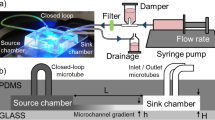Abstract
Creating and maintaining a precise molecular gradient which is stable in space and time are essential to studies of chemotaxis. This paper describes a simple, compact, and user-friendly microfluidic device using a passive pumping method to drive liquid flow to generate a stable concentration gradient. A fluidic circuit is designed to offset the effects of the pressure imbalance between the two inlets. After loading approximately the same amount of culture media containing different concentrations of a certain chemotactic agent into the two inlet reservoirs, a linear concentration gradient will be automatically and quickly established at the downstream. Our device takes advantage of passive pumping and is compact enough to fit into a Petri dish, which is an attractive feature to biologists. Furthermore, this microfluidic gradient generator offers a platform for a facile way of long-term imaging and analysis using high-resolution microscopy.







Similar content being viewed by others
References
Abhyankar VV, Lokuta MA, Huttenlocher A, Beebe DJ (2006) Characterization of a membrane-based gradient generator for use in cell-signaling studies. Lab Chip 6(3):389–393. doi:10.1039/b514133h
Berthier E, Beebe DJ (2007) Flow rate analysis of a surface tension driven passive micropump. Lab Chip 7(11):1475–1478. doi:10.1039/B707637a
Boyden S (1962) The chemotactic effect of mixtures of antibody and antigen on polymorphonuclear leucocytes. J Exp Med 115:453–466
Cheng SY, Heilman S, Wasserman M, Archer S, Shuler ML, Wu M (2007) A hydrogel-based microfluidic device for the studies of directed cell migration. Lab Chip 7(6):763–769. doi:10.1039/b618463d
Chung BG, Flanagan LA, Rhee SW, Schwartz PH, Lee AP, Monuki ES, Jeon NL (2005) Human neural stem cell growth and differentiation in a gradient-generating microfluidic device. Lab Chip 5(4):401–406. doi:10.1039/B417651k
Dertinger SKW, Chiu DT, Jeon NL, Whitesides GM (2001) Generation of gradients having complex shapes using microfluidic networks. Anal Chem 73(6):1240–1246. doi:10.1021/ac001132d
Dertinger SKW, Jiang XY, Li ZY, Murthy VN, Whitesides GM (2002) Gradients of substrate-bound laminin orient axonal specification of neurons. Proc Natl Acad Sci USA 99(20):12542–12547. doi:10.1073/pnas.192457199
Diao J, Young L, Kim S, Fogarty EA, Heilman SM, Zhou P, Shuler ML, Wu M, DeLisa MP (2006) A three-channel microfluidic device for generating static linear gradients and its application to the quantitative analysis of bacterial chemotaxis. Lab Chip 6(3):381–388. doi:10.1039/b511958h
Gerisch G, Keller HU (1981) Chemotactic reorientation of granulocytes stimulated with micropipettes containing fMet-Leu-Phe. J Cell Sci 52:1–10
Irimia D, Charras G, Agrawal N, Mitchison T, Toner M (2007) Polar stimulation and constrained cell migration in microfluidic channels. Lab Chip 7(12):1783–1790. doi:10.1039/B710524j
Jeon NL, Dertinger SKW, Chiu DT, Choi IS, Stroock AD, Whitesides GM (2000) Generation of solution and surface gradients using microfluidic systems. Langmuir 16(22):8311–8316. doi:10.1021/la000600b
Jeon NL, Baskaran H, Dertinger SKW, Whitesides GM, Van de Water L, Toner M (2002) Neutrophil chemotaxis in linear and complex gradients of interleukin-8 formed in a microfabricated device. Nat Biotechnol 20(8):826–830. doi:10.1038/Nbt712
Kohidai L (1995) Method for determination of chemoattraction in tetrahymena-pyriformis. Curr Microbiol 30(4):251–253
Lauffenburger DA, Horwitz AF (1996) Cell migration: a physically integrated molecular process. Cell 84(3):359–369. doi:10.1016/S0092-8674(00)81280-5
Lee K, Kim C, Ahn B, Panchapakesan R, Full AR, Nordee L, Kang JY, Oh KW (2009) Generalized serial dilution module for monotonic and arbitrary microfluidic gradient generators. Lab Chip 9(5):709–717. doi:10.1039/B813582g
Lee K, Kim C, Kim Y, Ahn B, Bang J, Kim J, Panchapakesan R, Yoon YK, Kang JY, Oh KW (2011) Microfluidic concentration-on-demand combinatorial dilutions. Microfluid Nanofluid 11(1):75–86. doi:10.1007/s10404-011-0775-8
Lin F, Saadi W, Rhee SW, Wang SJ, Mittal S, Jeon NL (2004) Generation of dynamic temporal and spatial concentration gradients using microfluidic devices. Lab Chip 4(3):164–167. doi:10.1039/b313600k
Longsworth LG (1953) Diffusion measurements, at 25°, of aqueous solutions of amino acids, peptides and sugars. J Am Chem Soc 75(22):5. doi:10.1021/ja01118a065
Lynn NS, Dandy DS (2009) Passive microfluidic pumping using coupled capillary/evaporation effects. Lab Chip 9(23):3422–3429. doi:10.1039/B912213c
McDonald JC, Whitesides GM (2002) Poly(dimethylsiloxane) as a material for fabricating microfluidic devices. Accounts Chem Res 35(7):491–499. doi:10.1021/Ar010110q
Saadi W, Rhee SW, Lin F, Vahidi B, Chung BG, Jeon NL (2007) Generation of stable concentration gradients in 2D and 3D environments using a microfluidic ladder chamber. Biomed Microdevices 9(5):627–635. doi:10.1007/s10544-007-9051-9
Shamloo A, Ma N, Poo MM, Sohn LL, Heilshorn SC (2008) Endothelial cell polarization and chemotaxis in a microfluidic device. Lab Chip 8(8):1292–1299. doi:10.1039/b719788h
Walker GM, Beebe DJ (2002) A passive pumping method for microfluidic devices. Lab Chip 2(3):131–134. doi:10.1039/B204381E
Walker GM, Sai J, Richmond A, Stremler M, Chung CY, Wikswo JP (2005) Effects of flow and diffusion on chemotaxis studies in a microfabricated gradient generator. Lab Chip 5(6):611–618. doi:10.1039/b417245k
Weiner OD (2002) Regulation of cell polarity during eukaryotic chemotaxis: the chemotactic compass. Curr Opin Cell Biol 14(2):196–202. doi:10.1016/S0955-0674(02)00310-1
White FM (2006) Viscous fluid flow. McGraw-Hill series in mechanical engineering, 3rd edn. McGraw-Hill Higher Education, New York
Zicha D, Dunn GA, Brown AF (1991) A new direct-viewing chemotaxis chamber. J Cell Sci 99(Pt 4):769–775
Zicha D, Dunn G, Jones G (1997) Analyzing chemotaxis using the Dunn direct-viewing chamber. Methods Mol Biol 75:449–457. doi:10.1385/0-89603-441-0:449
Acknowledgments
We thank Devi Majumdar and Rebecca Michaud for helpful discussion. This work was supported by National Institutes of Health (NIH) grant GM092914 to D.J.W. and by National Science Foundation (NSF) grant CBET0643583 to D.L.
Author information
Authors and Affiliations
Corresponding author
Electronic supplementary material
Below is the link to the electronic supplementary material.
Rights and permissions
About this article
Cite this article
Gao, Y., Sun, J., Lin, WH. et al. A compact microfluidic gradient generator using passive pumping. Microfluid Nanofluid 12, 887–895 (2012). https://doi.org/10.1007/s10404-011-0908-0
Received:
Accepted:
Published:
Issue Date:
DOI: https://doi.org/10.1007/s10404-011-0908-0




